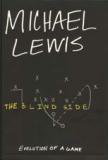Incredible Hulk
Michael Lewis is a splendid and exceptional writer. What creates the splendor is his gift for narrative pace, for sly wit, for the telling detail, for the clarity and verve of his sentences. What makes him exceptional is his ability to compose gripping tales about highly technical or dull subjects. In Liar’s Poker, he surprised us by making Wall Street investment banking and those barbarians in the bond market in the 1980’s both thrilling and hilarious. In The New New Thing he probed the circumambiences of Silicon Valley, where amateurism reigned and the billionaire geeks were kings. In Moneyball he concentrated on baseball’s apple-cart upsetters, who, by using heretofore arcane statistics for evaluation of players, not only revolutionized the game but, more important, saved money.
Once again he blindsides us readers with his latest book, The Blind Side, about the evolution of college and professional football. In the early 1980’s, a ferocious defensive linebacker for the New York Giants named Lawrence Taylor radically altered the game’s previous semi-stateliness, owing to his extraordinary ability to toss aside or circumvent blockers and sometimes literally, sometimes figuratively crush the opposing quarterback. Here was a huge problem demanding an even huger solution. The answer: hire a physical monster strong and agile enough to protect the “blind side” (that is, the left) of the (usually right-handed) quarterback by placing the monster in the left tackle position to “engage” the onrushing linebacker or defensive end and thwart his malign purposes. The economic upshot: once among the lowest paid in the sport, today a very good left tackle is either the highest or second-highest (to the quarterback) paid player on the team, with an average salary about $5.5 million per year. Here is clinching evidence for any sport sentimentalist that market principles dictate “values” and not notoriety or razzle-dazzle, because the successful exploits of the left tackle are seldom noticed by fans or the TV cameras (both tracking the ball)—unless, of course, he fails in his endeavors and the quarterback is sacked.
How and where can one find such talented and valuable monsters—men gargantuan in size, as agile as ballerinas, strong enough to ward off another speedy giant moving forward with malicious intent while they are moving backward and ferocious enough themselves to counter feral assaults? Such men are so rare (as the market confirms) that to call them “freaks of nature” is a compliment.
The discovery of such a specimen is the heart and soul of Lewis’s story and, not strictly speaking, the game of football. Football proper is as incidental to his narrative as the Mississippi is to Huckleberry Finn. And what a fascinating, truly amazing story it is, with countless vivid characters, marvelous dialogue and silences, endless surprises! At its center is Michael Oher, a black 16-year-old from Memphis, who, when we first meet him, is so gigantic that he looks like “a house entering another house.” Intermittently raised by his cocaine-addicted mother and one of 13 siblings by several inconstant fathers, he has since childhood grown up on the mean streets of a slum, scrounging for bare existence. The boy, we learn gradually, does not know his real name or his true birthday, and can neither read nor write. His ignorance is so profound that “he didn’t know what an ocean was, or a bird’s nest, or a tooth fairy.” He is a freak of nature in more ways than one.
Michael’s rescue and redemption, from rags to potential riches, involves a tale too improbable for serious fiction. An evangelical, staunchly conservative white couple take him under their wings well before his talents are manifest, and eventually become his legal guardians, making him “brother” to their daughter and son. In them we meet characters fascinating in their own right. He, Sean Tuohy, now a multimillionaire and well known throughout Memphis, was himself a poor boy from Louisiana who became a basketball star at Ole Miss, where he met and married Leigh Anne, a cheerleader, who matures into a generous-spirited, feisty, devout woman capable of disciplining and resurrecting Michael.
Lewis manages to interweave deftly the boy’s story with those of the Tuohys, as well as faculty members and administrators at Briarcrest Christian School, high-school football scouts and an indefatigable tutor. The fireworks (drolly described) begin when Michael’s special talents are discovered, and big-time coaches from the big-time universities swoop down and promise the illiterate Michael the moon (but never an education). At this point the reader witnesses right there in the Tuohys’ living room a national disgrace, the cheery exploitation of a woefully uneducated young athlete as one by one the suitors arrive with their tainted apples to lure Michael into their sports sanctuaries.
Not a pretty sight, that. But a wonderful story despite it.
This article also appeared in print, under the headline “Incredible Hulk,” in the January 29, 2007, issue.








